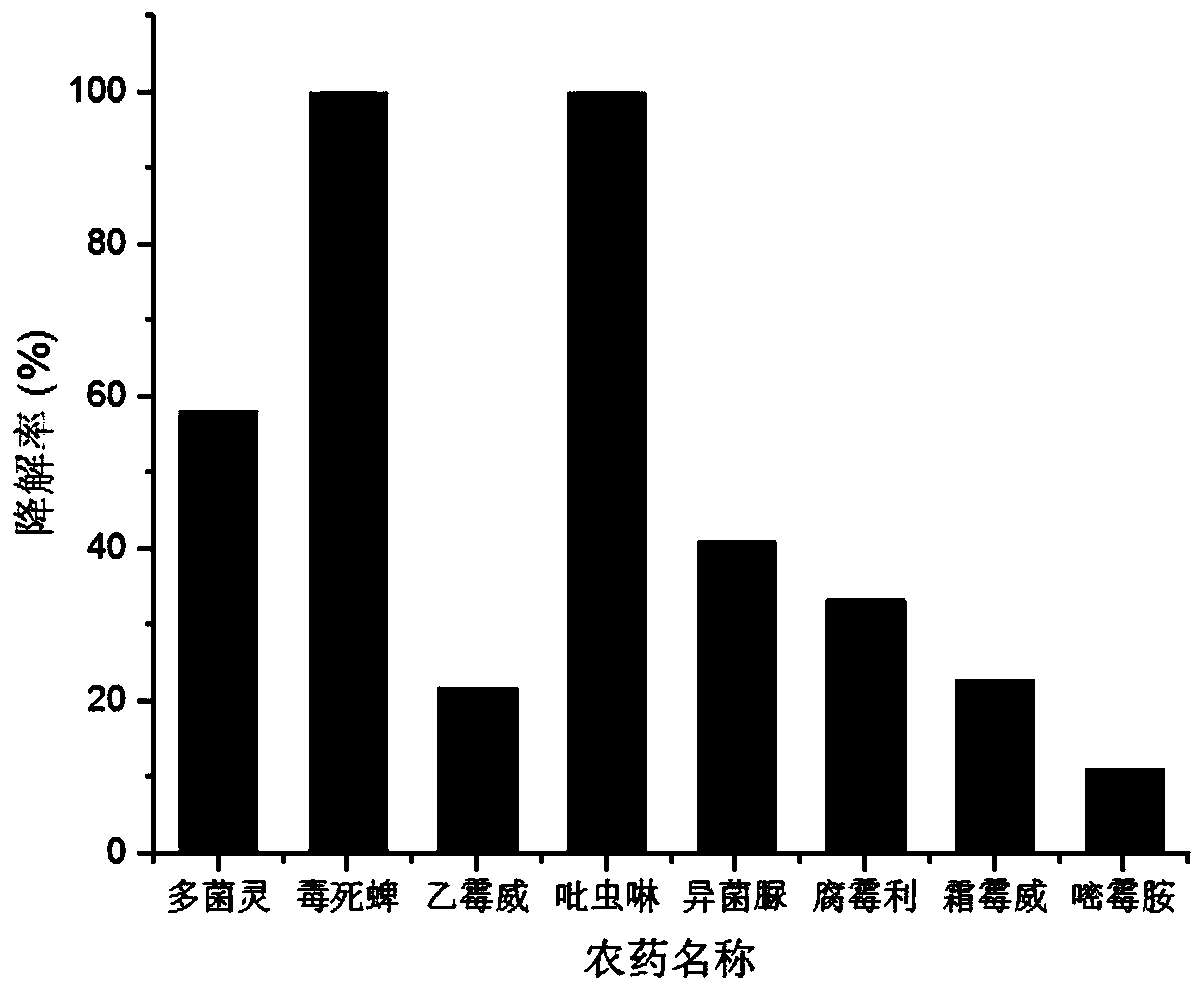Bacillus elongatus lysinus strain, enzyme preparation and its application in degrading pesticide residues
A technology of Bacillus lysine to degrade pesticides, applied in the field of biotechnology degradation of pesticide residues, can solve problems such as mixed pesticide residues that have not yet been seen, and achieve the effect of removing pesticide residues
- Summary
- Abstract
- Description
- Claims
- Application Information
AI Technical Summary
Problems solved by technology
Method used
Image
Examples
example 1
[0028] Example 1, isolation and identification of lysine bacillus strain
[0029] 1. Acquisition of strains
[0030] 1. Collection of soil samples
[0031] Collected from the sludge at the discharge outlet of the pesticide factory.
[0032] 2. Isolation and screening of target strains
[0033] Take by weighing sludge 10g in 100mL inorganic salt liquid medium, the composition of inorganic salt liquid medium is as follows:
[0034] MgSO 4 ·7H 2 O 0.2g; K 2 HPO 4 0.1g; (NH 4 ) 2 SO 4 0.1g; CaSO 4 0.04g; FeSO 4 ·7H 2 O0.001g; deionized water 1L; pH 7.0. Sterilize at 121°C for 30min.
[0035] Add chlorpyrifos with a concentration of 100mg / L to the inorganic salt liquid medium to obtain a culture solution, cultivate it on a shaker at 37°C and 180r / min, and after cultivating for one week, insert it into the fresh culture solution with a 10% inoculation amount, and then The turnover is connected once, so the domestication is repeated many times. Finally, isolate and ...
example 2
[0038] Example 2, induction and acclimatization of elongated lysine bacillus strain
[0039] 1. Chlorpyrifos induction and domestication
[0040] 1. The content range of active ingredients prepared by chlorpyrifos: 300mg / L-800mg / L. Tryptone agar containing different concentrations of chlorpyrifos was prepared. Different amounts of chlorpyrifos were added into tryptone agar to make a medium containing chlorpyrifos. Concrete steps: 1) Chlorpyrifos is prepared into a 4500 mg / L pesticide standard solution. Take 13.3mL, 17.8mL, 22.2mL, 26.6mL, 31.1mL, 35.6mL of pesticide standard solutions with a concentration of 4500mg / L and add them to 200mL tryptone agar to prepare chlorpyrifos containing 300mg / L, 400mg / L, 500mg / L , 600mg / L, 700mg / L and 800mg / L tryptone agar medium. Plate production: Pour the prepared tryptone agar containing 300mg / L-800mg / L chlorpyrifos into a plate, 15mL / plate, and use it after cooling and solidifying.
[0041] The components of tryptone agar are: 17g try...
example 3
[0055] Example 3, utilize elongated lysine bacillus strain FY-3 to prepare biodegradation enzyme preparation
[0056] 1. Obtaining the fermentation broth
[0057] 1. Strain expansion culture: Inoculate refrigerated strains into 100mL sterile TSB medium, cultivate at 37°C and 180rpm for 24 hours, and then they will become first-class seeds; transfer the first-class seeds to 1L with 10% inoculum volume In the TSB medium, cultivated at 37°C and 180rpm for 24 hours, it is the second-grade seed; transfer the second-grade seed to 10L industrial medium according to 10% inoculation amount, and cultivate it at 37°C and 180rpm for 24 hours, which is the third-grade seed seed.
[0058] 2. Inoculate the tertiary seeds into the fermenter, and the inoculation amount is 5% of the fermentation medium. Controlled ventilation volume is 2.5m 3 / h, the temperature is 37°C, the pH is 7.2±0.4, the rotation speed is 180rpm, samples are taken at intervals, and the OD is measured 600 And pH, in th...
PUM
 Login to View More
Login to View More Abstract
Description
Claims
Application Information
 Login to View More
Login to View More - R&D Engineer
- R&D Manager
- IP Professional
- Industry Leading Data Capabilities
- Powerful AI technology
- Patent DNA Extraction
Browse by: Latest US Patents, China's latest patents, Technical Efficacy Thesaurus, Application Domain, Technology Topic, Popular Technical Reports.
© 2024 PatSnap. All rights reserved.Legal|Privacy policy|Modern Slavery Act Transparency Statement|Sitemap|About US| Contact US: help@patsnap.com








